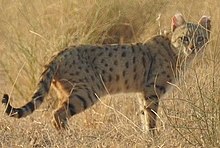Felis lybica
| Felis lybica | ||||||||||||
|---|---|---|---|---|---|---|---|---|---|---|---|---|

Felis lybica cafra |
||||||||||||
| Systematics | ||||||||||||
|
||||||||||||
| Scientific name | ||||||||||||
| Felis lybica | ||||||||||||
| Forster , 1780 |
Felis lybica is a kind from the family of cats , in three different subspecies in Africa , West Asia , Central Asia and India is native.
features
Felis lybica is sand-colored (beige to gray or reddish) and slender. Specimens that live in arid regions are usually lighter and less clearly streaked or spotted than those in wetter regions. Males reach a head-torso length of 46 to 74 cm, have a 25 to 36.8 cm long tail and reach a weight of 2 to 6.2 kg. With a head-torso length of 40.6 to 62 cm, a 22 to 35.5 cm long tail and a weight of 2 to 5.5 kg, females are usually slightly smaller and lighter than the males.
Felis lybica differs from the European wildcat ( Felis silvestris ) by its shorter fur and the morphology of the skull. Their muzzle is proportionally narrower, the rows of molars are longer and the molars are larger.
All three subspecies of Felis lybica resemble the (short-haired) domestic cats in appearance and shape . In these, however, the backs of the ears are usually dark gray or blackish, at most with a faint reddish tinge at the base of the ears, while the backs of the ears in the African wildcats are reddish brown and in the Asiatic yellowish or khaki colored . Felis lybica also has longer legs than domestic cats.
Subspecies and systematics
After a revision of the cat system published in 2017 by the Cat Specialist Group of the IUCN , Felis lybica is divided into three subspecies.
- The black cat or African wild cat ( Felis lybica lybica ) inhabits north, west and north of East Africa, the Arabian Peninsula and adjacent parts of Southwest Asia and some Mediterranean islands.
- Felis lybica cafra occurs in Africa south of the Congo Basin . The exact course of the border between the distribution areas of the black cat and F. l. cafra is unknown.
- The Asian wildcat or steppe cat ( Felis lybica ornata ) is widespread from Iran to western India and Central Asia, where it penetrates as far as northwest China and Mongolia.
The three subspecies were originally assigned to the wildcat ( Felis sylvestris ). Since the European wildcat has been considered an independent species since the revision of the cat system, Felis lybica became the scientific name for the collective species of the three subspecies. The name Felis lybica was introduced in 1780 by the German naturalist Georg Forster , in a work in which he dealt with the natural history of the French naturalist Georges-Louis Leclerc de Buffon .
Habitat and way of life


Due to the large distribution area that extends over two continents, Felis lybica occurs in very different habitats. The cats are usually absent in areas where the annual rainfall is less than 100 mm. Exceptions are dry areas in the immediate vicinity of a body of water. In addition, the habitat must offer cover in the form of shrubs, large tufts of grass, rocks or even cultivated plants . The cover is necessary both for sneaking up on prey and for hiding from larger predators. Felis lybica is nocturnal and mainly hunts on the ground, but can also climb. The main food of Felis lybica is rodents, insects and other arthropods, small reptiles such as skinks, lizards and snakes, small birds and in exceptional cases also somewhat larger mammals such as rabbits, hares, young antelopes and lambs are preyed on. A weight of three to four kilograms seems to be the upper limit for the weight of the prey.
Felis lybica is solitary and forms territories , whereby territories of the males are significantly larger than those of the females. The boundaries of the territories are marked by urine for both sexes. The utterances of Felis lybica correspond to those of the house cat. The gestation period is 56 to 65 days and one to five young animals are born per litter, which are born with their eyes closed and then have a weight of 80 to 120 grams. The births usually take place in an underground construction, a small cave, in a gap between rocks or in some other hiding place. Specimens of Felis lybica kept in captivity reproduced up to twice a year and reached a maximum age of 15 years.
Individual evidence
- ↑ a b c d African-Asian Wildcat Felis silvestris lybica and Felis silvestris ornata , pages 92 to 99. in Mel Sunquist, Fiona Sunquist: Wild Cats of the World. The University of Chicago Press, Chicago 2002, ISBN 0-226-77999-8 .
- ↑ Nobuyuki Yamaguchi, Carlos A. Driscoll, Andrew C. Kitchener & Jennifer M. Ward: Craniological differentiation between European wildcats ( Felis silvestris silvestris ), African wildcats ( F. s. Lybica ) and Asian wildcats ( F. s. Ornata ): Implications for their evolution and conservation. Biological Journal of the Linnean Society, 2004, 83, 47-63, DOI: 10.1111 / j.1095-8312.2004.00372.x
- ↑ a b Kitchener AC, Breitenmoser-Würsten Ch., Eizirik E., Gentry A., Werdelin L., Wilting A., Yamaguchi N., Abramov AV, Christiansen P., Driscoll C., Duckworth JW, Johnson W., Luo S.-J., Meijaard E., O'Donoghue P., Sanderson J., Seymour K., Bruford M., Groves C., Hoffmann M., Nowell K., Timmons Z. & Tobe S. 2017. A revised taxonomy of the Felidae. The final report of the Cat Classification Task Force of the IUCN / SSC Cat Specialist Group. Cat News Special Issue 11, 80 pp. Pages 17–20.
- ↑ Giovanni G. Bellani: Felines of the World: Discoveries in Taxonomic Classification and History. Academic Press, September 2019, ISBN 978-0128165034 , page 275 ff.
- ↑ Georg Forster (1780): Lord of Buffon's natural history of the quadruped animals. With Vermehrungen, translated from the French, Volume 6. J. Pauli, Berlin. Google Books
